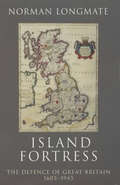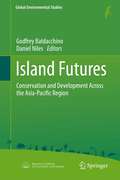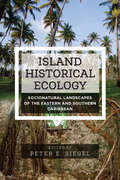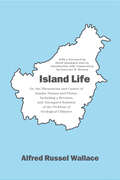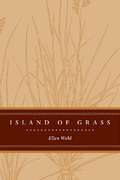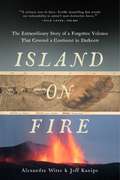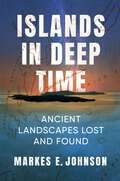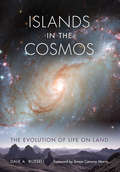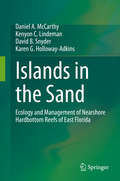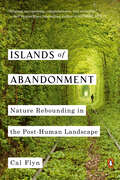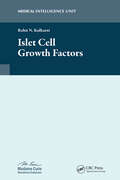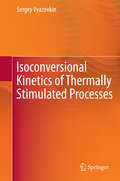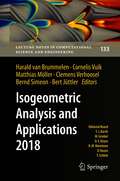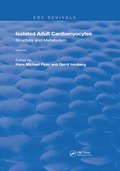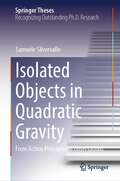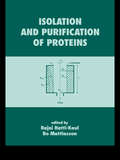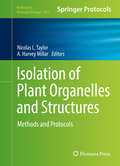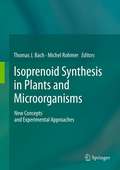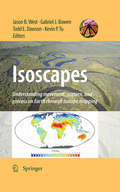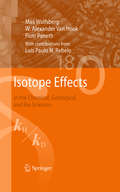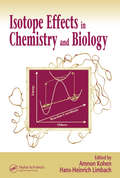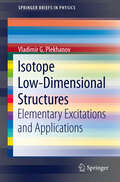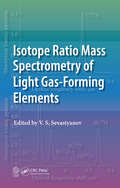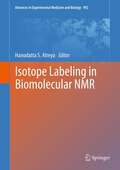- Table View
- List View
Island Fortress: The Defence of Great Britian 1606-1945
by Norman LongmateThe British Isles, it is often believed, have not been invaded for nearly a thousand years. In fact, as Norman Longmate reveals in this highly entertaining book (the successor to his acclaimed Defending the Island), foreign soldiers have landed on British soil on many occasions.In this definitive study of a long-neglected subject Norman Longmate make constant use of original sources, including contemporary eyewitness accounts. These are woven into an enthralling narrative, packed with fact - about weapons, ships, armies and fortresses - spiced with anecdote, and ranging over international and political as well as military and naval history. The result is above all an exciting story, which shows how, against all the odds, the British people managed to retain their freedom from the days of James I to those of George VI.
Island Futures
by Daniel Niles Godfrey BaldacchinoIslands face one of the most pressing issues of our time: how to balance ecological integrity with economic development and collective quality of life, including the need for social and conservation space. Islands are sites of rich and varied human and ecological diversity, but they are also often characterized by narrow resource bases and dependency on links to the outside world, and by their limited ability to determine the actual character of those links. This volume reviews the challenges of island development and conservation in the Asia-Pacific region. With emphasis on nature reserves and UNESCO World Heritage sites, chapters describe the benefits, barriers, and potential pitfalls in preserving such sites, managing biota, and attracting and controlling tourism. The book also provides a provocative challenge to move beyond the typical concerns of "sustainability" to the more holistic concept of "futurability", or "future potential" for convivial human-environmental interactions.
Island Historical Ecology: Socionatural Landscapes of the Eastern and Southern Caribbean
by Peter E. SiegelIn the first book-length treatise on historical ecology of the West Indies, Island Historical Ecology addresses Caribbean island ecologies from the perspective of social and cultural interventions over approximately eight millennia of human occupations. Environmental coring carried out in carefully selected wetlands allowed for the reconstruction of pre-colonial and colonial landscapes on islands between Venezuela and Puerto Rico. Comparisons with well-documented patterns in the Mediterranean and Pacific islands place this case study into a larger context of island historical ecology.
Island Life: Or, the Phenomena and Causes of Insular Faunas and Floras, Including a Revision and Attempted Solution of the Problem of Geological Climates
by Alfred Russel WallaceAlfred Russel Wallace is best known as the codiscoverer, with Charles Darwin, of natural selection, but he was also historyOCOs foremost tropical naturalist and the father of biogeography, the modern study of the geographical basis of biological diversity. "Island Life" has long been considered one of his most important works. In it he extends studies on the influence of the glacial epochs on organismal distribution patterns and the characteristics of island biogeography, a topic as vibrant and actively studied today as it was in 1880. The book includes historyOCOs first theory of continental glaciation based on a combination of geographical and astronomical causes, a discussion of island classification, and a survey of worldwide island faunas and floras. aaaaaaaaaaaThe year 2013 will mark the centennial of WallaceOCOs death and will see a host of symposia and reflections on WallaceOCOs contributions to evolution and natural history. This reissue of the first edition of "Island Life," with a foreword by David Quammen and an extensive commentary by Lawrence R. Heaney, who has spent over three decades studying island biogeography in Southeast Asia, makes this essential and foundational reference available and accessible once again. "
Island of Grass
by Ellen E. WohlIsland of Grass tells the story of the Cathy Fromme Prairie Natural Area, a 240-acre preserve surrounded by housing developments in Fort Collins, Colorado. This small grassland is a remnant of the once-vast prairies of the West that early European explorers and settlers described as seas of grass. Agricultural land use and urban expansion during the past two centuries have fragmented and altered these prairies. All that remains today are small islands. These remnants cannot support some of the larger animals that once roamed the prairie, but they continue to support a diverse array of plants and animals and can still teach us much about grassland ecology. Through her examinations of daily changes during walks across the Fromme Prairie over the course of a year, Ellen Wohl explores one of the more neglected ecosystems in North America, describing the geology, soils, climate, ecology, and natural history of the area, as well as providing glimpses into the lives of the plants, animals, and microbes inhabiting this landscape. Although small in size, pieces of preserved shortgrass prairie like the Cathy Fromme Prairie Natural Area are rich, diverse, and accessible natural environments deserving of awareness, appreciation, and protection. Anyone concerned with the ecology and conservation of grasslands in general, the ecology and conservation of open space in urban areas, or the natural history of Colorado will be interested in this book.
Island on Fire: The Extraordinary Story of a Forgotten Volcano That Changed the World
by Jeff Kanipe Alexandra WitzeCan a single explosion change the course of history? An eruption at the end of the 18th century led to years of climate change while igniting famine, disease, even perhaps revolution. Laki is one of Iceland's most fearsome volcanoes. Laki is Iceland's largest volcano. Its eruption in 1783 is one of history's great, untold natural disasters. Spewing out sun-blocking ash and then a poisonous fog for eight long months, the effects of the eruption lingered across the world for years. It caused the deaths of people as far away as the Nile and created catastrophic conditions throughout Europe. Island on Fire is the story not only of a single eruption but the people whose lives it changed, the dawn of modern volcanology, as well as the history--and potential--of other super-volcanoes like Laki around the world. And perhaps most pertinently, in the wake of the eruption of another Icelandic volcano, Eyjafjallajökull, which closed European air space in 2010, acclaimed science writers Witze and Kanipe look at what might transpire should Laki erupt again in our lifetime.
Islands in Deep Time: Ancient Landscapes Lost and Found
by Markes E. JohnsonHilltops surrounded by farmland in southern Wisconsin turn out to be the eroded remnants of an ancient archipelago. An island in the Yellow Sea where Korean tourists flock is the peak of a flooded mountain rising from a drowned continental shelf. From a mountaintop shrine to Genghis Khan in Inner Mongolia, the silhouette of a Silurian seascape can be spotted. On the shores of Hudson Bay, where polar bears patrol the Arctic tundra, a close look unveils what was a tropical coastline encrusted with corals nearly 450 million years ago.The geologist Markes E. Johnson invites readers on a journey through deep time to find the traces of ancient islands. He visits a dozen sites around the globe, looking above and below today’s waterlines to uncover how landscapes of the past are preserved in the present. Going back 500 million years to the Cambrian through the Pleistocene 125,000 years ago, this book reconstructs how “paleoislands” appeared under different climatic conditions and environmental constraints. Finding vestiges of prehistoric ecologies, Johnson emphasizes the complexity of island ecosystems and the importance of preserving these significant sites.Inviting and accessible, this book is a travelogue that takes readers through time as well as space. Islands in Deep Time shares the adventure of exploring striking locations across geologic eras and issues a passionate call for their conservation.
Islands in the Cosmos
by Dale A. RussellHow is it that we came to be here? The search for answers to that question has preoccupied humans for millennia. Scientists have sought clues in the genes of living things, in the physical environments of Earth from mountaintops to the depths of the ocean, in the chemistry of this world and those nearby, in the tiniest particles of matter, and in the deepest reaches of space. In Islands of the Cosmos, Dale A. Russell traces a path from the dawn of the universe to speculations about our future on this planet. He centers his story on the physical and biological processes in evolution, which interact to favor more successful, and eliminate less successful, forms of life. Marvelously, these processes reveal latent possibilities in life's basic structure, and propel a major evolutionary theme: the increasing proficiency of biological function. It remains to be seen whether the human form can survive the dynamic processes that brought it into existence. Yet the emergence of the ability to acquire knowledge from experience, to optimize behavior, to conceptualize, to distinguish "good" from "bad" behavior all hint at an evolutionary outcome that science is only beginning to understand.
Islands in the Sand: Ecology and Management of Nearshore Hardbottom Reefs of East Florida
by Kenyon C. Lindeman David B. Snyder Daniel A. McCarthy Karen G. Holloway-AdkinsNearshore hardbottom reefs of Florida’s east coast are used by over 1100 species of fishes, invertebrates, algae, and sea turtles. These rocky reefs support reproduction, settlement, and habitat use, and are energy sources and sinks. They are also buried by beach renourishment projects in which artificial reefs are used for mitigation. This comprehensive book is for research scientists and agency personnel, yet accessible to interested laypersons including beachfront residents and water-users.An unprecedented collection of research information and often stunning color photographs are assembled including over 1250 technical citations and 127 figures. These shallow reefs are part of a mosaic of coastal shelf habitats including estuarine seagrasses and mangroves, and offshore coral reefs.These hardbottom habitats are federally designated as Essential Fish Habitats - Habitats of Particular Concern and are important feeding areas for federally-protected sea turtles. Organismal and assemblage responses to natural and man-made disturbances, including climate change, are examined in the context of new research and management opportunities for east Florida’s islands in the sand.
Islands of Abandonment: Nature Rebounding in the Post-Human Landscape
by Cal FlynA beautiful, lyrical exploration of the places where nature is flourishing in our absenceSome of the only truly feral cattle in the world wander a long-abandoned island off the northernmost tip of Scotland. A variety of wildlife not seen in many lifetimes has rebounded on the irradiated grounds of Chernobyl. A lush forest supports thousands of species that are extinct or endangered everywhere else on earth in the Korean peninsula's narrow DMZ.Cal Flyn, an investigative journalist, exceptional nature writer, and promising new literary voice visits the eeriest and most desolate places on Earth that due to war, disaster, disease, or economic decay, have been abandoned by humans. What she finds every time is an "island" of teeming new life: nature has rushed in to fill the void faster and more thoroughly than even the most hopeful projections of scientists.Islands of Abandonment is a tour through these new ecosystems, in all their glory, as sites of unexpected environmental significance, where the natural world has reasserted its wild power and promise. And while it doesn't let us off the hook for addressing environmental degradation and climate change, it is a case that hope is far from lost, and it is ultimately a story of redemption: the most polluted spots on Earth can be rehabilitated through ecological processes and, in fact, they already are.
Islet Cell Growth Factors
by Rohit N. KulkarniThis book, Islet Cell Growth Factors, provides a timely contribution to the current thinking regarding the concepts in the area of islet cell regeneration with special reference to insulin secreting beta cells. The contributions are from leaders in the field with a long-standing interest in the area of islet biology.In the first chapter Drs. Dirice
Isoconversional Kinetics of Thermally Stimulated Processes
by Sergey VyazovkinThe use of isoconversional kinetic methods for analysis of thermogravimetric and calorimetric data on thermally stimulated processes is quickly growing in popularity. The purpose of this book is to create the first comprehensive resource on the theory and applications of isoconversional methodology. The book introduces the reader to the kinetics of physical and chemical condensed phase processes that occur as a result of changing temperature and discusses how isoconversional analysis can provide important kinetic insights into them. The book will help the readers to develop a better understanding of the methodology, and promote its efficient usage and successful development.
Isocyanide Chemistry
by V. NenajdenkoThe efficacy of isocyanide reactions in the synthesis of natural or naturallike products has resulted in a renaissance of isocyanide chemistry. Now isocyanides are widely used in different branches of organic, inorganic, coordination, combinatorial and medicinal chemistry.This invaluable reference is the only book to cover the topic in such depth, presenting all aspects of synthetic isonitrile chemistry. The highlyexperienced and internationally renowned editor has brought together an equally distinguished team of authors who cover multicomponentreactions, isonitriles in total synthesis, isonitriles in polymer chemistry and much more.
Isogeometric Analysis and Applications 2018 (Lecture Notes in Computational Science and Engineering #133)
by Bert Jüttler Bernd Simeon Harald Van Brummelen Cornelis Vuik Matthias Möller Clemens VerhooselThis proceedings volume gathers a selection of outstanding research papers presented at the third Conference on Isogeometric Analysis and Applications, held in Delft, The Netherlands, in April 2018. This conference series, previously held in Linz, Austria, in 2012 and Annweiler am Trifels, Germany, in 2014, has created an international forum for interaction between scientists and practitioners working in this rapidly developing field. Isogeometric analysis is a groundbreaking computational approach that aims to bridge the gap between numerical analysis and computational geometry modeling by integrating the finite element method and related numerical simulation techniques into the computer-aided design workflow, and vice versa. The methodology has matured over the last decade both in terms of our theoretical understanding, its mathematical foundation and the robustness and efficiency of its practical implementations. This development has enabled scientists and practitioners to tackle challenging new applications at the frontiers of research in science and engineering and attracted early adopters for this his novel computer-aided design and engineering technology in industry. The IGAA 2018 conference brought together experts on isogeometric analysis theory and application, share their insights into challenging industrial applications and to discuss the latest developments as well as the directions of future research and development that are required to make isogeometric analysis an established mainstream technology.
Isolated Adult Cardiomyocytes: Structure and Metabolism (Routledge Revivals #1)
by Hans Michael Piper Gerrit IsenbergFirst published in 1989, written with contributions from experts who have critically evaluated the state of the art and the prospects of isolated adults cardiac myocytes in cardiological research, this two-volume publication summarizes the current knowledge of this technology. The methodology, structure, and metabolism of cardiomyocytes are presented, along with metabolism and cation homeostasis and energy metabolism and hypoxic injury. Additionally, cell isolation and culture and the structure and biochemistry of the sarcolemma is explained. Electrophysiology and contractile function with ionic currents and membrane channels is discussed. Also, the electro-physiological effects of transmitters and hormones are presented, with excitation-contraction coupling and the use of cardiomyocytes in drug design and research explained.
Isolated Objects in Quadratic Gravity: From Action Principles to Observations (Springer Theses)
by Samuele SilvervalleOne of the main unanswered question of modern Physics is "How does gravity behave at small scales?". The aim of this thesis is to illustrate in a comprehensive but accessible way how to look for deviations from Einstein's theory of General Relativity in this regime, looking at the simplest celestial bodies: static and spherically symmetric ones.With a conservative and bottom-up approach, at smaller scales the first corrections to the action of General Relativity are generally considered to be terms quadratic in the curvature tensors; while these modifications do not cure the inconsistency between gravity and quantum mechanics, the solutions of this theory are plausible candidates to be the first-order corrections of the classical ones.Even with such simple modifications, a striking picture emerges from the study of isolated objects: the unique Schwarzschild solution of General Relativity is only a rare bird in the set of solutions, with non-Schwarzschild black holes, wormholes and naked singularities appearing as possible substitutes.Tailored to graduate students and researchers entering this field, this thesis shows how to construct these new solutions from action principles, how to characterize their metric, how to study their physical properties, such as their stability or Thermodynamics, and how to look for phenomenological signatures.
Isolation and Purification of Proteins (Biotechnology And Bioprocessing Ser. #Vol. 27)
by Rajni Hatti-Kaul Bo MattiassonThis publication details the isolation of proteins from biological materials, techniques for solid-liquid separation, concentration, crystallization, chromatography, scale-up, process monitoring, product formulation, and regulatory and commercial considerations in protein production. The authors discuss the release of protein from a biological host, selectivity in affinity chromatography, precipitation of proteins (both non-specific and specific), extraction for rapid protein isolation, adsorption as an initial step for the capture of proteins, scale-up and commercial production of recombinant proteins, and process monitoring in downstream processing.
Isolation of Plant Organelles and Structures
by Nicolas L. Taylor A. Harvey MillarThis book brings together the major techniques used in the isolation or enrichment of individual populations of organelles and other subcellular structures from plants with the goal that, by being able to isolate subcellular structures, the research and understanding of various facets of compartmentalized function in plant cells can be advanced. Written for the highly successful Methods in Molecular Biology series, expert contributors provide chapters that contain introductions to their respective topics, lists of the necessary materials and reagents, step-by-step, readily reproducible laboratory protocols, and tips on troubleshooting and avoiding known pitfalls. Authoritative and practical, Isolation of Plant Organelles and Structures: Methods and Protocols will greatly aid those who regularly isolate subcellular components as well as those whose research has lead them to focus on a subcellular compartment or a particular process for the first time, thus producing the need to be able to isolate it or enrich it for study.
Isoprenoid Synthesis in Plants and Microorganisms
by Michel Rohmer Thomas J. BachIsoprenoids are important in primary and secondary metabolism. They have implications in a myriad of physiological processes notably in plants, microorganisms and parasites, and biological activities at the cellular, organism, and ecosystem levels. The importance of isoprenoids in various areas of the scientific world has spurred intense research worldwide. Also their role in "nutraceuticals" has stimulated scientific curiosity. Literature on isoprenoids is widely scattered in journals with quite differing readerships and geographic distribution. A comprehensive book on isoprenoids does not exist. Isoprenoid Synthesis in Plants and Microorganisms: New Concepts and Experimental Approaches fills this gap by presenting the latest and the most applicable information on isoprenoids. The most recent TERPNET conference serves as the backdrop and provides much of the inspiration for the topics covered in the book. Additional topics of interest are covered as well, making Isoprenoid Synthesis in Plants and Microorganisms: New Concepts and Experimental Approaches the most comprehensive review of isoprenoid synthesis to date.
Isoscapes
by Todd E. Dawson Gabriel J. Bowen Jason B. West Kevin P. TuStable isotope ratio variation in natural systems reflects the dynamics of Earth systems processes and imparts isotope labels to Earth materials. Carbon isotope ratios of atmospheric CO2 record exchange of carbon between the biosphere and the atmosphere; the incredible journeys of migrating monarchs is documented by hydrogen isotopes in their wings; and water carries an isotopic record of its source and history as it traverses the atmosphere and land surface. Through these and many other examples, improved understanding of spatio-temporal isotopic variation in Earth systems is leading to innovative new approaches to scientific problem-solving. This volume provides a comprehensive overview of the theory, methods, and applications that are enabling new disciplinary and cross-disciplinary advances through the study of "isoscapes": isotopic landscapes. "This impressive new volume shows scientists deciphering and using the natural isotope landscapes that subtly adorn our spaceship Earth.", Brian Fry, Coastal Ecology Institute, Louisiana State University, USA "An excellent timely must read and must-have reference book for anybody interested or engaged in applying stable isotope signatures to questions in e.g. Anthropology, Biogeochemistry, Ecology, or Forensic Science regarding chronological and spatial movement, changes, or distribution relating to animals, humans, plants, or water.", Wolfram Meier-Augenstein, Centre for Anatomy & Human Identification, University of Dundee, UK "Natural resources are being affected by global change, but exactly where, how, and at what pace? Isoscapes provide new and remarkably precise answers.", John Hayes, Woods Hole Oceanographic Institution, USA "This exciting volume is shaping a new landscape in environmental sciences that is utilizing the remarkable advances in isotope research to enhance and extend the capabilities of the field.", Dan Yakir, Weizmann Institute of Science, Israel
Isotope Effects
by Luís Paulo Rebelo W. Alexander Van Hook Max Wolfsberg Piotr PanethAs the title suggests, Isotope Effects in the Chemical, Geological and Bio Sciences deals with differences in the properties of isotopically substituted molecules, such as differences in the chemical and physical properties of water and the heavy waters. Since the various fields in which isotope effects are applied do not only share fundamental principles but also experimental techniques, this book includes a discussion of experimental apparatus and experimental techniques. Isotope Effects in the Chemical, Geological and Bio Sciences is an educational monograph addressed to graduate students and others undertaking isotope effect research. The fundamental principles needed to understand isotope effects are presented in appropriate detail. While it is true that these principles are more familiar to students of physical chemistry and some background in physical chemistry is recommended, the text provides enough detail to make the book an asset to students in organic and biochemistry, and geochemistry.
Isotope Effects In Chemistry and Biology
by Amnon Kohen Hans-Heinrich LimbachThe field of isotope effects has expanded exponentially in the last decade, and researchers are finding isotopes increasingly useful in their studies. Bringing literature on the subject up to date, Isotope Effects in Chemistry and Biology covers current principles, methods, and a broad range of applications of isotope effects in the physical, biolo
Isotope Low-Dimensional Structures
by Vladimir G. PlekhanovThis Briefs volume describes the properties and structure of elementary excitations in isotope low-dimensional structures. Without assuming prior knowledge of quantum physics, the present book provides the basic knowledge needed to understand the recent developments in the sub-disciplines of nanoscience isotopetronics, novel device concepts and materials for nanotechnology. It is the first and comprehensive interdisciplinary account of the newly developed scientific discipline isotopetronics.
Isotope Ratio Mass Spectrometry of Light Gas-Forming Elements
by V. S. SevastyanovIsotope Ratio Mass Spectrometry of Light Gas-Forming Elements explores different methods of isotope analysis, including spark, secondary ion, laser, glow discharge, and isotope ratio mass spectrometry. It explains how to evaluate the isotopic composition of light elements (H, C, N, O) in solid, liquid, and gaseous samples of organic and inorganic s
Isotope labeling in Biomolecular NMR
by Hanudatta S. AtreyaNMR spectroscopy has undergone a revolution in recent years with the advent of several new methods overcoming the problems of sensitivity and resolution. Recent developments in biotechnology have made it easier and economical to introduce 13C, 15N and 2H into proteins and nucleic acids. At the same time, there has been an explosion in the number of NMR experiments that utilize such isotope labeled samples. Thus, a combination of isotopic labeling and multidimensional, multinuclear NMR has opened up new avenues for structural studies of proteins, nucleic acids and their complexes. This book will focus on recent developments in isotope labeling methods for structural studies of small molecules, peptides, proteins and nucleic acids. The aim of the book is to serve as a compendium of isotope labeling for the biomolecular NMR community providing comprehensive coverage of the existing methods and latest developments along with protocols and practical hints on the various experimental aspects. The book will cover a wide range of topics in isotope labeling under one title including emerging areas of metabolonomics and solid state NMR.
